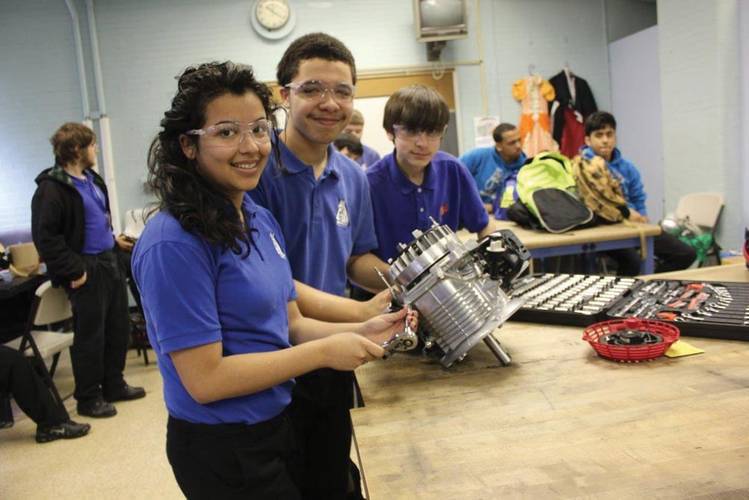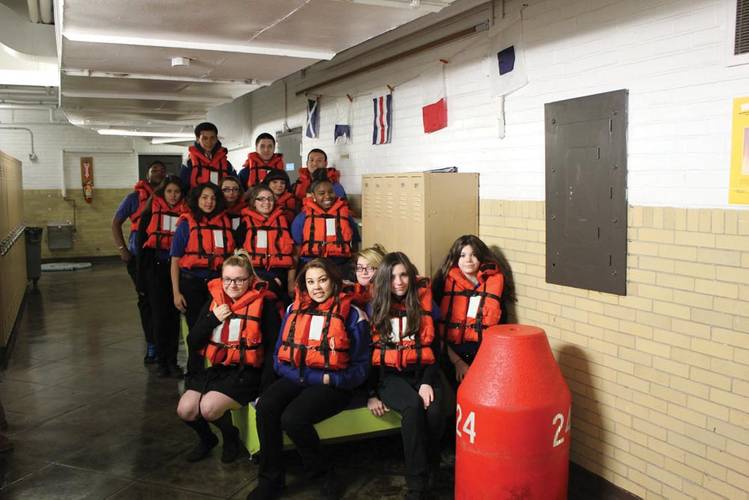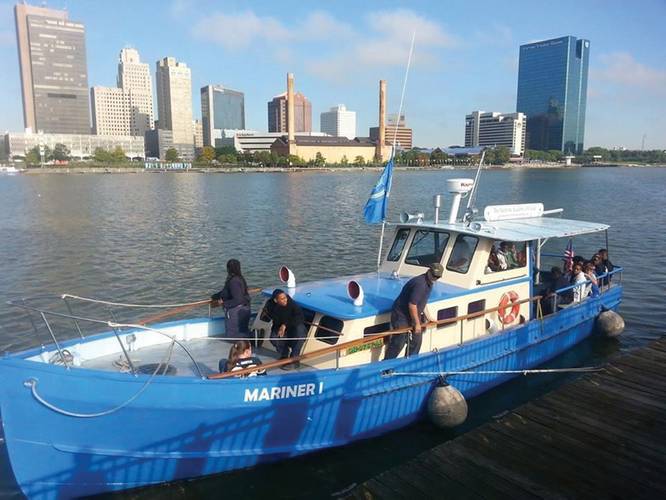The Rise of Primary and Secondary Maritime Schools
Education for the next generation, employment for life. A new source of talent emerges for maritime stakeholders everywhere.
Primary and secondary maritime schools are sprouting up across the country, inspiring K-12 students to learn about the exciting, yet sometimes obscured domestic waterfront. The goals of these maritime school programs are many and multifaceted, but at the core they motivate and engage students by bringing something new and exciting to the classroom while giving teachers an effective means for capturing the attention of their classes. And as new student audiences are being exposed — earlier, rather than later — to the maritime industry and potential career paths that could lie ahead, it’s not only students and educators who stand to reap the rewards of these programs.
The domestic maritime industry, spanning blue and brown water mariners, dock workers, operations, oil and gas and a dozen other sectors is starving for fresh, young talent to meet a shortage of qualified workers, especially in entry level and crew positions. What better way to work toward filling these gaps than to educate the nations’ youth on the importance of its culture-rich maritime heritage?
The Beginnings of Maritime Education
Formal maritime training in the United States began to take shape with the opening of the U.S. Naval Academy and the first civil maritime school in New York City in the mid 1800s, answering the call for more advanced training to meet the demands of evolving ships and marine technology. Maritime education received another boost with a resurgence of marine activity following World War II. In 1946, the War Shipping Administration transferred former Liberty Ship SS John Brown to the New York City Board of Education to serve as part of the Metropolitan Vocational High School, providing high school students with deck, engine and stewards training until a declining interest in vocational education and shipping opportunities forced its closure in 1982.
The Marine Engineers Beneficial Association (MEBA), open from 1966-1986, offered a three-year program designed to train high school graduates to become licensed third assistant engineers in the Southern Hotel in Baltimore through formal classroom education and onboard trainee apprenticeships.
Still in operation today, the Seaman’s International Union (SIU) created the Paul Hall Center for Maritime Training in Piney Point, Md. in 1967 with a center that conducts professional and vocational training for unlicensed seaman. The school has put more than 21,000 high school graduates between the ages of 18-30 through an apprentice program consisting of classroom and shipboard training to qualify as entry level seamen in the deck, engine and stewards department.
Renewed Focus
A major turning point for maritime education occurred in 2001 when the Maritime Administration (MARAD) and U.S. Coast Guard (USCG), recognizing a shortage of mariners, hosted a conference at the U.S. Merchant Marine Academy called “Maritime Careers Creating an Action Plan for Recruiting and Retaining American Mariners.” Prominently among the topics covered at the conference was “Public Education and Awareness of the Maritime Industry,” which sparked a follow-up meeting on implementing action plans in 2002.
The movement gained momentum and focus in the years followed. Helping to lead the charge was Capt. Art Sulzer (USN Ret.). If not the founding father of modern maritime primary/secondary education in America, he is still by far its biggest champion. His involvement in maritime secondary education dates back to the early 2000’s when he was commissioned to share his maritime insight with a newly forming charter school in Philadelphia. Well known in maritime circles, Sulzer currently serves as a Presidential appointee on the St. Lawrence Seaway Board. Sulzer has done a lot of things, but his education push is one of his most high profile efforts. Sulzer, who holds an Ed.D. from the University of Pennsylvania with a focus on primary and secondary maritime education, testified to congress in on the subject in 2008.
Also in 2008, the Ship Operators Cooperative Program (SOCP) sponsored a two-day event titled “Maritime and Intermodal Education for Primary and Secondary Schools in America - On Board to a Future Career.” Gathering participants spanning the industry, from government agencies and existing maritime middle and high schools, to private companies and individuals, all came together with the shared goal of advancing maritime awareness in the United States and introducing K-12 students to what the maritime industry has to offer. In his keynote address, Rep. Elijah Cummings (D.-Md.), then Chairman of the Committee on Coast Guard and Maritime Education, highlighted the national problem of low graduation rates at city schools across the country (50 percent of city high school students do not graduate), offering maritime education as an opportunity to expose students to something interesting to focus on.
From the conference spawned the SOCP’s Maritime Education and Workforce Development Committee to continue initiatives addressed at the conference, and from there launched the Maritime for Primary and Secondary Education Coalition (MPSEC) to foster and promote maritime education in urban schools by working with a network of local, state and federal agencies, private employers, maritime associations, higher education institutions and other interested partners.
To date the MPSEC has led a number of widespread initiatives promoting maritime education, including the development of a national model curriculum for grades 5-12, a national maritime/transportation introductory course introducing 9th graders to related careers ashore and afloat, a 10th grade course on entry level maritime skills, an “Adopt a Maritime School” program and a project to expand e-learning in maritime schools, to name a few.
These initiatives are working, Sulzer said, but the proof is also in the numbers: “In 2001 there was one maritime high school and two marine high schools, and in 2008 there were maybe a dozen. Now in 2014, there are over 40 marine, maritime and transportation type high schools around the country.”
About the Schools
The existing maritime schools are mostly found near major U.S. ports along the Atlantic and Pacific Coasts, as well as on the Great Lakes, in cities such as Philadelphia, New York, Toledo , San Diego, Houston, Baltimore, Palm Beach and Seattle. The schools can be separated into two main categories: marine, which focuses on oceanology, biology and marine sciences; and maritime, which deals with subjects, training and skills required to work in the maritime sector, whether it be as a crew member at sea or shoreside such as in a marine, shipyard or port facility.
The schools teach general subjects (math, science, history, etc.) “marinated” with maritime themes, Sulzer said. Each school meets required state common core requirements, but with a maritime flavor. This is accomplished in a number of ways. Sulzer lists several program styles and types to categorize primary and secondary schools used to present marine and maritime materials to the students.
Many marine and maritime schools follow one or more of the program styles or types. Sulzer explained that grades K-8 usually follow a more integrated-type program, where 9-12 get more specific into industry related materials.
The New York Harbor School, for example, has all the same core academic programs as and standard public high school but on top of that has a four year scope and sequence of Career and Technical Education Coursework which gives students an introductory course in 9th grade before steering them toward choosing one of several college and industry approved Career and Technical Education Coursework routes: aquaculture, marine biology research, marine systems technology, ocean engineering, scientific diving and vessel operations.“That allows [students] to focus on something they can be good at, even if they haven’t been good in traditional academic subjects,” said the school’s cofounder Murray Fisher.
“We do a good job in helping kids find ways to be successful,” Fisher added, “Finding, multiple ways to be successful is important.” The New York Harbor School offers safe, engaging and fun opportunities that are often hard to find for inner city kids, Fisher explained.
The Maritime Academy Charter High School in Philadelphia (Pennsylvania’s only maritime-specific charter school), with Sulzer as one of its founding board members, started as a grade 5-8 school, but has since expanded to a 4-12 school with 820 students and ambitions to expand to K-12. “We teach the maritime industry. Of course our focus is on academics, but we intertwine the state’s common core standard curriculum with maritime themes,” said Ed Poznek, the school’s Principal and CEO.
“People come to our school because we offer strong academics . . . students and their families come to us because of who we are and the reputation that we carry,” Poznek said. Its reputation is well deserved. The Maritime Academy has a 98 percent graduation rate, nearly double the national average for urban schools. Poznek credits the maritime factor as a chief driving force behind the school’s success. “Our students really take pride in the fact that they are called cadets, especially our 4th, 5th and 6th grade students. It gives them a sense of pride unlike other schools,” Poznek explained. “The standards and expectations of a cadet are much higher, and we emphasize that our students do their best and give 100 percent.”
Another maritime school, the Maritime Academy of Toledo, initially embarked with the ambition to bring inner city kids and their families to the water through a focus on recreational boating, eventually evolving (with Sulzer’s help) to a maritime-centered program by the time it opened its doors in 2006. It too has benefited greatly from maritime themes, and has seen enrollment increase every year.
To achieve success, educators and administrators at maritime schools have found creative ways to integrate maritime themes. Students in Toledo are on the school’s boat every day of the week for courses in art, math, music, geography, etc. The school offers a diverse range of maritime courses, covering everything from welding and ecosystems, to fishing to culinary.
“Everything you can imagine that connects curriculum content to the water is what my teachers are doing,” said Renee Marazon, founder and Superintendent of The Maritime Academy of Toledo. For Cinco de Mayo, students in Toledo’s school used simulators to navigate waters in Mexico. “It’s so much fun to see these kids light up when they’re learning and exploring – and enjoying learning. The kids are learning to love to learn.”
Poznek said the Philadelphia school takes frequent maritime-themed fieldtrips, such as its most recent visit to Penn Terminal, where students were given the opportunity to learn about what the terminal does and how it serves the maritime industry. “It’s exciting for a group of students to stand in front of a ship and learn about the operations that occur.” The school has also taken its students aboard bulk carriers, tugboats and tall ships.
Maritime educators advocate that infusing maritime themes in primary and secondary schools helps to hold students attention while generating, enthusiasm, excitement, camaraderie and discipline. That positivity seems poised to transcend to the commercial sector.
The NextStep – Industry Cooperation
For many maritime schools, the next step is to connect students with potential employers, or as Sulzer describes it, “pass the baton.” Graduates from these programs have received an introduction to the maritime world and are well positioned to take up jobs within a sector that so desperately needs new workers. “The first thing is we get kids to graduate. The second is we help develop their academic standards,” Sulzer said. “The third thing, which is where we are now, is we need to take these young people and hand them off, whether it’s to an employer, a maritime academy, a union trade school or two-year maritime college. We need to hand them off to make sure they don’t fall through the cracks.”
Poznek said the Maritime Academy is very much tied into Philadelphia’s local maritime community, with connections to the Port of Philadelphia and most of the city’s maritime organizations. “As a result, Poznek said, “the maritime industry knows about our school; they know about our students.”
Next, the school plans to expand internship and externship possibilities “for students to actually go out into the business community and interact with the maritime businesses, and of course learn more about maritime opportunities,” Poznek said, adding that the school has recently hired a new guidance counselor to help students explore potential maritime careers.
According to Fisher, the New York Harbor School essentially prepares its 450 9th-12th grade students for positions in the marine and maritime field: “It’s introducing our kids to job markets that are very underrepresented by women and minorities while training them for an entry level job in that career.” After completing required internships within the local community, students have earned a technical credential and are prepared for entry level jobs upon graduation, though Fisher said most of his students seek college educations first.
Similarly, as part of its strong working relationship with the maritime industry, the Toledo academy holds a number career day events throughout the year to present students to employers. Students’ senior projects align them with an industry within the community, and the school is currently preparing other internship and apprenticeship programs. Maritime companies want quality employees, and these schools are working to provide that through industry communication and cooperation. “When you begin to network and interface with the corporations that way, then they’re interested in your graduates,” Marazon said, adding that companies even call the school looking for employee candidates. Companies such as Interlake Steamship and Crowley are already aboard.
Cole Cosgrove, vice president of marine operations for liner services at Crowley, believes there is much to be gained from these types of maritime education programs: “The main thing is getting the maritime training and careers out in front of younger folks early on so that they know that that’s an option that they have, especially when a lot of those skills can be developed outside of a formal college education,” he said. “[The schools provide] a great opportunity to infuse maritime topics into the standard ABCs of learning.”
“We encourage our labor partners to take a look at the schools and see if there are any viable candidates to bring into apprenticeship programs,” Cosgrove said. “The maritime industry is all about the people. The ships, the tugs and barges, the pilot boats and the passenger boats. Nothing moves unless you have really good qualified people, and it’s really important to get those folks into the industry and get experience when they’re young.”
As existing maritime schools evolve and new ones emerge, more industry partners will look to get involved. Possibilities are mounting. Cosgrove said, “We’re just seeing the first graduates from the schools now, so it will be interesting to see if the earlier exposure to maritime turns into additional people that are interested in coming into the field.”
According to Sulzer the next big step involves spreading the word. Maritime schools help to raise awareness about an industry that is too often overlooked. Now it’s time for leaders across the sector to pitch in. The maritime industry has so much to offer a new generation, and vice versa. As the industry cries out for new workers, maritime schools are proof that young people are ready to heed the call.
(As published in the June 2014 edition of Marine News - http://magazines.marinelink.com/Magazines/MaritimeNews)






















